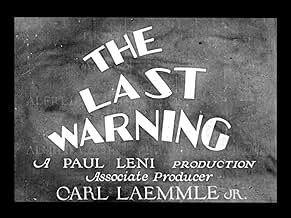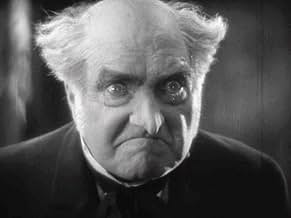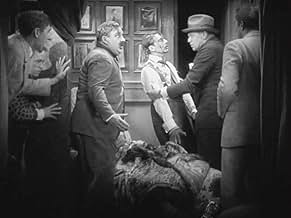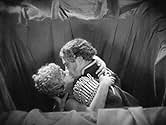AVALIAÇÃO DA IMDb
6,8/10
924
SUA AVALIAÇÃO
Adicionar um enredo no seu idiomaA producer decides to reopen a theater, that had been closed five years previously when one of the actors was murdered during a performance, by staging a production of the same play with the... Ler tudoA producer decides to reopen a theater, that had been closed five years previously when one of the actors was murdered during a performance, by staging a production of the same play with the remaining members of the original cast.A producer decides to reopen a theater, that had been closed five years previously when one of the actors was murdered during a performance, by staging a production of the same play with the remaining members of the original cast.
- Direção
- Roteiristas
- Artistas
Carrie Daumery
- Barbara Morgan
- (as Mme. Carrie Daumery)
Slim Summerville
- Tommy Wall
- (as 'Slim' Summerville)
Bud Phelps
- Sammy
- (as 'Buddy' Phelps)
Charles K. French
- Doctor
- (não creditado)
Pat Harmon
- Cop
- (não creditado)
Francisco Marán
- Jeffries
- (não creditado)
Avaliações em destaque
"The Last Warning" (1928) was Paul Leni's last film as director before his untimely death from sepsis at the age of 44. Starring Laura La Plante, Montague Love, John Boles, Margaret Livingston, Roy D'Arcy, and a host of other pre-eminent silent film actors of the day, this film continues in the vein of "The Cat and the Canary" (1927), another Leni film starring Laura La Plante. Based on a successful 1922 play, the film opens on a stage play where John Woodford (D'Arcy Corrigan) is on stage reaching for a candle, but dies as the mechanical candle electrocutes Woodford. Now, the play is halted, police called in, and, after a series of several hectic and quickly moved-through scenes, the body disappears, never to be seen again. Five years later, a "producer", Montague Love, decides to re-open the theater - which had been closed in the interim - and re-stage the same play Woodford had been killed performing in, and now have the same cast perform the play for the re-opening of the theater. Roy D'Arcy will replace Woodford in that part and John Boles will replace D'Arcy in his old part. Well, D'Arcy is nearly electrocuted during a rehearsal; then seemingly disappears! Boles replaces D'Arcy, and the play opens that night! Near the scene where the candle is to be reached for and grabbed, the police - a group of at least 10 and perhaps a couple of unsuspected persons who might be the police - are ready for anything.
The photography; that is, the movement of the camera, what it captures and how, is how Leni made his reputation. He'd done remarkable things with films like "Hintertreppe" (1921), "Waxworks" (1924) and "The Man Who Laughs" (1928). Hal Mohr was Leni's cinematographer on this shoot, and the fluidity and creative shooting is what makes this film a cinematic masterpiece. The story is rather "old dark house", and it's fun, with comic touches and dramatic incident, but it's the deft direction and smart editing, along with a cast of pros, that makes this film something to enjoy and wish to come back to in the future.
There were a few sound scenes added to the original release that are no longer extant. The restored version is quite good, though a few scratches here and there, especially near the beginning and end, are evident. My print is the European restored one from Eureka Masters of Cinema. I needed to re-set my Blu-Ray to Region 2 to play it. It didn't do it automatically.
The opening and closing scenes have been described as 'kaleidoscopic', and that is a perfect description. Wonderful cinematography and editing throughout make this a wonderful experience over 90 years after release! Highly recommended. Among others in the remarkable cast are Burr McIntosh, Bert Roach, Mack Swain, Slim Summerville, and Carrie Daumery.
The photography; that is, the movement of the camera, what it captures and how, is how Leni made his reputation. He'd done remarkable things with films like "Hintertreppe" (1921), "Waxworks" (1924) and "The Man Who Laughs" (1928). Hal Mohr was Leni's cinematographer on this shoot, and the fluidity and creative shooting is what makes this film a cinematic masterpiece. The story is rather "old dark house", and it's fun, with comic touches and dramatic incident, but it's the deft direction and smart editing, along with a cast of pros, that makes this film something to enjoy and wish to come back to in the future.
There were a few sound scenes added to the original release that are no longer extant. The restored version is quite good, though a few scratches here and there, especially near the beginning and end, are evident. My print is the European restored one from Eureka Masters of Cinema. I needed to re-set my Blu-Ray to Region 2 to play it. It didn't do it automatically.
The opening and closing scenes have been described as 'kaleidoscopic', and that is a perfect description. Wonderful cinematography and editing throughout make this a wonderful experience over 90 years after release! Highly recommended. Among others in the remarkable cast are Burr McIntosh, Bert Roach, Mack Swain, Slim Summerville, and Carrie Daumery.
This dazzling example of late silent cinema was available only in shoddy, awful looking prints for 80 years or more, until it was restored in 2016 and finally released on home video in 2019, and now for the most part looks fantastic. It was the final film made by the great Paul Leni, whose magnificent "The Man Who Laughs" is one of the absolutely essential silent works everyone needs to see at least once before they die.
The story of this one is a cross between The Cat And The Canary and The Phantom of The Opera, but not really as good as either: an actor is killed onstage and everyone in the cast and crew becomes a suspect; the theatre closes for years until the play is revived, and the killer plans to kill all over again. There's secret passageways and cobwebs galore, and a decent enough mystery, but it's got to be said the plot's a little messy and hard to follow at times.
It's in the visuals that The Last Warning really shines, with the camera in every scene swooping and zooming in on every action taking place, and great use of depth of field to draw one's eyes to things happening in the background: the camera is always doing something, always telling us something about the story and the characters, purely through visual means. This is the very peak of what silent cinema was reaching for at the end of the 1920s, just before the talkies came in the following year and largely destroyed that artform and the box of tricks it used for everyone but Alfred Hitchcock, at least until Citizen Kane came along. I always like to imagine what might have happened if sound had not been introduced for another 15 or twenty years; what visual magic and ways of imparting story through image might have been achieved.
In summation, then: not the most compelling or meaningful story but one full of energy, movement and endless inventiveness. A great delight for the eyes.
7½/10.
The story of this one is a cross between The Cat And The Canary and The Phantom of The Opera, but not really as good as either: an actor is killed onstage and everyone in the cast and crew becomes a suspect; the theatre closes for years until the play is revived, and the killer plans to kill all over again. There's secret passageways and cobwebs galore, and a decent enough mystery, but it's got to be said the plot's a little messy and hard to follow at times.
It's in the visuals that The Last Warning really shines, with the camera in every scene swooping and zooming in on every action taking place, and great use of depth of field to draw one's eyes to things happening in the background: the camera is always doing something, always telling us something about the story and the characters, purely through visual means. This is the very peak of what silent cinema was reaching for at the end of the 1920s, just before the talkies came in the following year and largely destroyed that artform and the box of tricks it used for everyone but Alfred Hitchcock, at least until Citizen Kane came along. I always like to imagine what might have happened if sound had not been introduced for another 15 or twenty years; what visual magic and ways of imparting story through image might have been achieved.
In summation, then: not the most compelling or meaningful story but one full of energy, movement and endless inventiveness. A great delight for the eyes.
7½/10.
Last Warning, The (1929)
*** 1/2 (out of 4)
Paul Leni (The Cat and the Canary, The Man Who Laughs) directs this Universal horror film, which has been forgotten over the years but if you've seen some of the studios bigger pictures then you've can tell what all this film has influenced. A popular show on Broadway, inside a creepy theatre, is closed down after the mysterious murder of one of the actors. Years later the police reassemble the original cast and bring them back to the theater to see if they can trap the murderer but it might be a ghost they're dealing with. This film mixes elements of The Phantom of the Opera with the old dark house themes of films like The Bat and delivers a terrific entertainment. This film has never been officially released so I had to view it via what appears to be a 16mm print and the quality was pretty bad throughout so if I get a chance to see a pristine print then I'll probably bump my review up. The technical eye of Leni, who died after this film, is untouched by nearly everyone as he's constantly trying new and different things with the camera. I love how he'll have a medium shot and then move the camera in to show some evidence before moving it back out to let the action role. The film runs just under 80-minutes and goes by very fast with some exciting action but also a great story to work with. The actors, including John Boles who would later appear in Frankenstein, all do nice work as well. There are a few twists and turns along the way that actually work well within the story. This film works on a technical level as well as the story level and that makes this a wonderful little gem that needs to be rediscovered. The only thing people know about this movie nowdays is that it was a huge influence on James Whale and this is easy to see. There's a woman here, used as comic relief, which is later a carbon copy in Una O'Connor. The Old Dark House also lifts some shots here but I won't say which ones since it'll ruin scenes in both movies. The score here was also later reused in Dracula and this film was shot on the same sets as The Phantom of the Opera so there's a lot of connections here.
*** 1/2 (out of 4)
Paul Leni (The Cat and the Canary, The Man Who Laughs) directs this Universal horror film, which has been forgotten over the years but if you've seen some of the studios bigger pictures then you've can tell what all this film has influenced. A popular show on Broadway, inside a creepy theatre, is closed down after the mysterious murder of one of the actors. Years later the police reassemble the original cast and bring them back to the theater to see if they can trap the murderer but it might be a ghost they're dealing with. This film mixes elements of The Phantom of the Opera with the old dark house themes of films like The Bat and delivers a terrific entertainment. This film has never been officially released so I had to view it via what appears to be a 16mm print and the quality was pretty bad throughout so if I get a chance to see a pristine print then I'll probably bump my review up. The technical eye of Leni, who died after this film, is untouched by nearly everyone as he's constantly trying new and different things with the camera. I love how he'll have a medium shot and then move the camera in to show some evidence before moving it back out to let the action role. The film runs just under 80-minutes and goes by very fast with some exciting action but also a great story to work with. The actors, including John Boles who would later appear in Frankenstein, all do nice work as well. There are a few twists and turns along the way that actually work well within the story. This film works on a technical level as well as the story level and that makes this a wonderful little gem that needs to be rediscovered. The only thing people know about this movie nowdays is that it was a huge influence on James Whale and this is easy to see. There's a woman here, used as comic relief, which is later a carbon copy in Una O'Connor. The Old Dark House also lifts some shots here but I won't say which ones since it'll ruin scenes in both movies. The score here was also later reused in Dracula and this film was shot on the same sets as The Phantom of the Opera so there's a lot of connections here.
Astute producer Carl Laemmle invited talented German director Paul Leni to join Universal. This proved to be a masterstroke. Before his untimely death in 1929 Leni directed four films one of which, 'The Chinese Parrot' is considered 'lost', the other three of which are superb. From its astonishing opening sequence 'The Last Warning' is a brilliantly inventive and imaginative piece that holds our attention throughout. A great deal of credit must surely go to cinematographer Hal Mohr who, although American born, had assimilated European film techniques during a brief sojourn in Paris. His greatest achievement is the 'Midsummer Night's Dream' of Max Reinhardt. The specially composed score although a little over-orchestrated, is far superior to the usual incongruous, excruciating, tacked on scores with which so many restored silent films are cursed. Such a sadness to lose a director of Leni's gifts but his influence on Universal's classic horrors of the 1930's is there for all to see.
"The Cat and the Canary" (1927) must've been a popular entry in what was already a crowded field of old-dark-house horror comedies in the final years of the silent era. One need look no further for evidence of that fact than this followup film, "The Last Warning," which reunited director Paul Leni and star Laura Le Plante, as well as a couple of the same writers and art director, for a similar spooky murder mystery with the slight novelty that it's set in a theatre this time. Moreover, the next year, following Leni's death, Universal released a talkie remake of "The Cat and the Canary," the now-lost "The Cat Creeps" (1930). (Likewise, "The Last Warning" was later remade as "The House of Fear" (1939), which is the title of the book from which the play and, thus, the films were derived.) Although Leni's two films were based on different plays, it seems that many of these narratives tended to be strikingly similar, with perhaps the stage version of "The Bat" being the originator of the formula, which itself was made twice for the screen by Roland West ("The Bat" (1926) and "The Bat Whispers" (1930)). The other successful Universal property that "The Last Warning" clearly borrows from is "The Phantom of the Opera" (1925) by reusing its auditorium set, and like Gaston Leroux's story, the stage setting of "The Last Warning" features a play-within-a-play structure--offering a self-reflexive twist on the familiar old-dark-house formula.
Personally, although I've been reviewing quite a few of these films lately, I'm not a fan of the formula--at least not until James Whale introduced a more campy sense of humor and more twisted subject matter with "The Old Dark House" (1932). Before that, they tended to be exceedingly silly, relying on characters' fear of ghosts, and the mysteries are hardly interesting, if not appallingly convoluted. That of "The Last Warning" is especially of little concern, with nary a clue offered throughout the proceedings before an intricate resolution clumsily ties everything together in the end. The main point of the construction, though, was to replay the antics of the 1927 film. So, once again, there's a whodunit, the body of which disappears, and a group of suspects are brought together under one roof, where they're excessively scared that a ghost is behind all of the horrors. As in "The Bat" and "The Cat and the Canary," there's a masked menace creeping through hidden passages haunting the place. By employing "The Phantom of the Opera" set, the similarity between these haunted house plays to Leroux's story becomes blatant, as well, with both featuring a masked menace terrorizing its occupants. Unlike Leroux's Phantom, however, this one has no Christine, but rather insists that no play be performed at all.
Like "The Cat and the Canary," Leni's style here goes a long way in at least making them visually appealing. The superimpositions, including kaleidoscopic images, the moving title effects and moving-camera shots stand out. Originally, there were also sound effects and dialogue scenes, making this late silent film a goat gland and offering the additional technical marvelry of sound. More interesting, though, and why I like this a bit more than "The Cat and the Canary" and most of the other early old dark houses is the honesty of the self-reference of how shamelessly this film imitates its predecessors. In it, the same cast and crew are brought back together to perform the same play they performed years ago, when the original murder occurred, and this is essentially what Leni and the rest of the Universal staff were doing in making the film--bringing back the same cast and crew to perform basically the same play they performed years ago. Even where the cast isn't exactly the same in the two films, the different actors mimic some of the same types of the prior one--so much so that I initially thought that at least a couple others besides Le Plante had appeared in "The Cat and the Canary" as well. Appropriately, the play-within-the-play is titled "The Snare," the play itself being a snare to uncover the murderer in the narrative. In fact, the most we ever get of the inner play is from the point-of-views of the producer and stage hands as spectators of the culprit being lured in by their ruse, and not of the actual play performed for the theatre audience, whose perspectives we don't share. But, the real snare is the trap set by the filmmakers to lure audiences back for the same film in a new guise.
(Note: The reduction prints out there for home viewing are horrendous, but there is a restored version that has appeared at festivals. Hopefully, it'll receive a home video release someday like its companion piece, "The Cat and the Canary.")
Personally, although I've been reviewing quite a few of these films lately, I'm not a fan of the formula--at least not until James Whale introduced a more campy sense of humor and more twisted subject matter with "The Old Dark House" (1932). Before that, they tended to be exceedingly silly, relying on characters' fear of ghosts, and the mysteries are hardly interesting, if not appallingly convoluted. That of "The Last Warning" is especially of little concern, with nary a clue offered throughout the proceedings before an intricate resolution clumsily ties everything together in the end. The main point of the construction, though, was to replay the antics of the 1927 film. So, once again, there's a whodunit, the body of which disappears, and a group of suspects are brought together under one roof, where they're excessively scared that a ghost is behind all of the horrors. As in "The Bat" and "The Cat and the Canary," there's a masked menace creeping through hidden passages haunting the place. By employing "The Phantom of the Opera" set, the similarity between these haunted house plays to Leroux's story becomes blatant, as well, with both featuring a masked menace terrorizing its occupants. Unlike Leroux's Phantom, however, this one has no Christine, but rather insists that no play be performed at all.
Like "The Cat and the Canary," Leni's style here goes a long way in at least making them visually appealing. The superimpositions, including kaleidoscopic images, the moving title effects and moving-camera shots stand out. Originally, there were also sound effects and dialogue scenes, making this late silent film a goat gland and offering the additional technical marvelry of sound. More interesting, though, and why I like this a bit more than "The Cat and the Canary" and most of the other early old dark houses is the honesty of the self-reference of how shamelessly this film imitates its predecessors. In it, the same cast and crew are brought back together to perform the same play they performed years ago, when the original murder occurred, and this is essentially what Leni and the rest of the Universal staff were doing in making the film--bringing back the same cast and crew to perform basically the same play they performed years ago. Even where the cast isn't exactly the same in the two films, the different actors mimic some of the same types of the prior one--so much so that I initially thought that at least a couple others besides Le Plante had appeared in "The Cat and the Canary" as well. Appropriately, the play-within-the-play is titled "The Snare," the play itself being a snare to uncover the murderer in the narrative. In fact, the most we ever get of the inner play is from the point-of-views of the producer and stage hands as spectators of the culprit being lured in by their ruse, and not of the actual play performed for the theatre audience, whose perspectives we don't share. But, the real snare is the trap set by the filmmakers to lure audiences back for the same film in a new guise.
(Note: The reduction prints out there for home viewing are horrendous, but there is a restored version that has appeared at festivals. Hopefully, it'll receive a home video release someday like its companion piece, "The Cat and the Canary.")
Você sabia?
- CuriosidadesSets from O Fantasma da Ópera (1925) used.
- ConexõesFeatured in Terror Universal (1998)
Principais escolhas
Faça login para avaliar e ver a lista de recomendações personalizadas
- How long is The Last Warning?Fornecido pela Alexa
Detalhes
- Data de lançamento
- País de origem
- Idioma
- Também conhecido como
- The Last Warning
- Locações de filme
- Empresas de produção
- Consulte mais créditos da empresa na IMDbPro
- Tempo de duração
- 1 h 29 min(89 min)
- Cor
- Mixagem de som
Contribua para esta página
Sugerir uma alteração ou adicionar conteúdo ausente




































